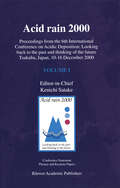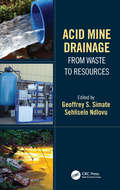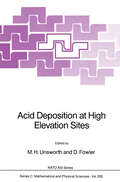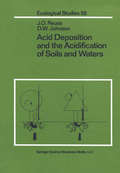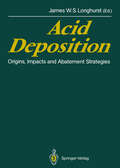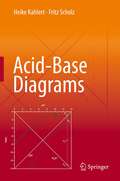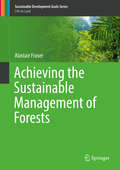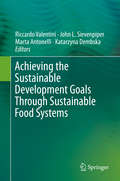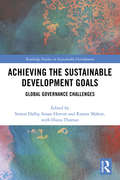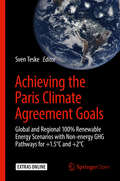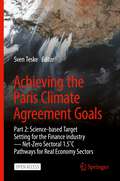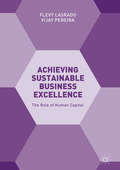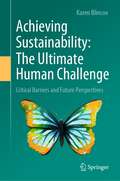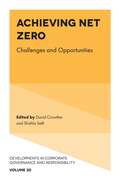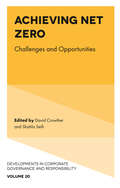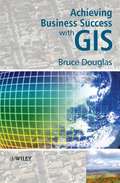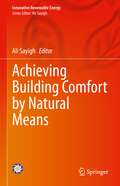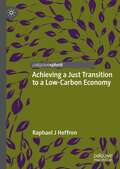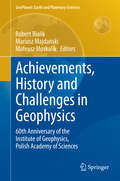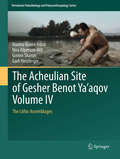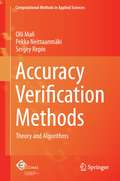- Table View
- List View
Acid rain 2000: Proceedings from the 6th International Conference on Acidic Deposition: Looking back to the past and thinking of the future, Tsukuba, Japan, 10–16 December 2000
by Kenichi SatakeThe Acid Rain 2000 Conference in Tsukuba, Japan, held 10-16 December 2000, was the sixth such conference in the series, starting with Columbus, Ohio, USA, in 1975, and including Sandefjord, Norway, in 1980, Muskoka, Canada, in 1985, Glasgow, UK, in 1990, and Göteborg, Sweden, in 1995. This series of International Conferences on the acid rain problem has made a very important contribution to the process of summarising the state of current understanding and making this information available. In the 6th Conference, approximately 600 papers were presented, including talks and posters. About 300 peer-reviewed papers from the presentation appear in this volume, and will provide readers with a comprehensive review of the history and scientific aspects of the acid rain problem. The papers appear in three volumes: the first containing the plenary and keynote papers and the other two the remaining scientific papers. (Volume 1: ISBN 0-7923-7132-1; Volume 2: ISBN 0-7923-7133-X; Volume 3: ISBN 0-7923-7134-8). The Conference was arranged under the joint auspices of The Science Council of Japan, The Japanese Society of Limnology (representative academic society), Japan Association of Aerosol Science and Technology, The Japan Society for Analytical Chemistry, Japan Society for Atmospheric Environment, Chemical Society of Japan, The Ecological Society of Japan, The Japanese Society of Environmental Education, Society of Environmental Science, Japan, The Japanese Forestry Society, Japanese Society of Snow and Ice, Japanese Society of Soil Science and Plant Nutrition, and Japan Society on Water Environment, with the cooperation of Ibaraki Prefecture and Japan Environment Agency.
Acid Mine Drainage: From Waste to Resources
by Geoffrey S. Simate Sehliselo NdlovuAcid mine drainage (AMD) is essentially the flow of water polluted with metals and other substances from existing/old mining areas and is considered to be one of the sources of pollution. A wide range of technologies are available for preventing AMD generation and/or treating AMD before discharge, but there is a shift towards recovery of industrially useful materials and products from AMD. Acid Mine Drainage: From Waste to Resources explores novel methods developed for the reuse and/or recovery of industrially useful materials from AMD including discussing generation, prediction, prevention, and remediation processes. It includes legislation and policy frameworks governing AMD and its environmental/health impacts. Provides a detailed overview of the mining operations and discusses the geochemical and hydrogeological context of acid mine drainage AMD formation, prediction and impact Presents a holistic approach to AMD generation, prediction, prevention, and remediation processes Presents exclusive material on reuse, recycling, and recovery of industrially useful materials from AMD Gives a detailed overview of the legislation and policy regulatory framework governing the management of AMD Analyses the effects of AMD on the environment and health This volume is aimed at researchers and professionals in metallurgical engineering, chemical engineering, environmental engineering, and mining engineering, including policy makers.
Acid Mine Drainage: From Waste to Resources
by Geoffrey S. Simate Sehliselo NdlovuAcid mine drainage (AMD) is essentially the flow of water polluted with metals and other substances from existing/old mining areas and is considered to be one of the sources of pollution. A wide range of technologies are available for preventing AMD generation and/or treating AMD before discharge, but there is a shift towards recovery of industrially useful materials and products from AMD. Acid Mine Drainage: From Waste to Resources explores novel methods developed for the reuse and/or recovery of industrially useful materials from AMD including discussing generation, prediction, prevention, and remediation processes. It includes legislation and policy frameworks governing AMD and its environmental/health impacts. Provides a detailed overview of the mining operations and discusses the geochemical and hydrogeological context of acid mine drainage AMD formation, prediction and impact Presents a holistic approach to AMD generation, prediction, prevention, and remediation processes Presents exclusive material on reuse, recycling, and recovery of industrially useful materials from AMD Gives a detailed overview of the legislation and policy regulatory framework governing the management of AMD Analyses the effects of AMD on the environment and health This volume is aimed at researchers and professionals in metallurgical engineering, chemical engineering, environmental engineering, and mining engineering, including policy makers.
Acid Deposition at High Elevation Sites (Nato Science Series C: #252)
by M. H. Unsworth D. FowlerThere is no shortage of general books on the subject of acid rain, or of symposium proceedings reviewing work ranging from atmospheric chemistry and deposition processes to freshwater acidification and effects on vegetation. In contrast, the collection of papers from this Workshop is focussed on a much smaller subject, the processes of acid deposition at high altitude sites. Interest in deposition at high elevation sites comes largely from observed vertical gradients in the degree of forest damage at sites in the Federal Republic of Germany and the eastern United States. These gradients show that damage to Norway spruce and fir increases with altitude at sites in Bavaria and the Black Forest, and that Red spruce are declining at high elevation sites in the Appalachian Mountains. With the large scale of scientific interest in forest decline, cany research groups, during the last five years, have been examining atmospheric chemistry, deposition processes, and effects on vegetation and soils at upland sites. In particular there have been many recent studies of cloud and precipitation chemistry, which show much larger concentrations of all ions in cloud water than in rain or snow. These studies have also shown that processes of wet and dry deposition and also the chemistry of the air at hill tops are modified strongly by orographic effects.
Acid Deposition and the Acidification of Soils and Waters (Ecological Studies #59)
by J.O. Reuss D.W. JohnsonThe majority of this book was written in 1983-84 while the senior author was a Visiting Scientist at Oak Ridge National Laboratory (ORNL) in Oak Ridge, Tennessee. We believe that the approach to the problem of acid deposition effects on soils and waters developed during this collaboration contains ele ments that are significantly different from most prior work in this area. Some of the material and the software used in the development of these concepts stem from earlier individual efforts of the authors. However, what we believe to be the more significant concepts concerning the processes by which alkalinity may be developed in acid soil solutions, and by which acid deposition may contrib ute to the loss of this alkalinity, were the result of this collaboration. The ultimate usefulness of these concepts in understanding and dealing with various aspects of the problems associated with acid deposition cannot be adequately gauged at the present time. They must first withstand tests of con sistency with available observation, and of direct experimentation. It is our hope that dissemination through this book will facilitate this process within the scientific community. The authors wish to thank the administration of the Environmental Science Division at ORNL, and the College of Agricultural Sciences at Colorado State University for their support in arranging this collaboration. We also wish to express our appreciation for the financial support provided by EPA. Personal thanks are due to Dr.
Acid Deposition: Proceedings of the CEC Workshop organized as part of the Concerted Action “Physico-Chemical Behaviour of Atmospheric Pollutants”, held in Berlin, 9 September 1982
by S. Beilke A. J. ElshoutProceedings of the EEC Workshop organized within the Framework of the Concerted Action "Physico-Chemical Behaviour of Atmospheric Pollutants", held in Berlin, 9 September 1982
Acid Deposition: Origins, Impacts and Abatement Strategies
by James W. S. LonghurstThe subject of acid deposition remains one of the most urgent of our contemporary environmental problems. Research programmes are continually redefming our understanding of cause and effect and hence the continuing need for a timely and authoritative series addressing these issues. This volume seeks to review and defme our contemporary understanding of acid deposition by reference to new international data and as a consequence assist the definition of our future research requirements and policy developments. International contributions to the volume are drawn from the Federal Republic of Germany, the U.S.A., Canada, Brazil, Switzerland, Austria, Israel, France and the United Kingdom. Some of these nations have experienced acid deposition on a regional scale for considerable periods of time; for others the phenomenon is an emerging problem. This collection of papers has been compiled by invitation to eminent members of the acid deposition research community and by selection from a carefully targeted call for papers. It is primarily designed to meet the needs of researchers, lecturers and postgraduate students in environmental disciplines and for environmental policy makers. It is of interest to professionals in related disciplines and essential as a reference text for libraries. The volume is divided into four broad themes: Emissions, chemistry and deposition; Ecosystem effects (freshwater, soils and forest systems); Effects on structural materials; Mitigation, control and management. Each of these sections provides an overview of contemporary understanding, presents new experimental or field evidence and provides guidance for our future research agenda.
Acid-Base Diagrams
by Heike Kahlert Fritz ScholzUnderstanding acid-base equilibria made easy for students in chemistry, biochemistry, biology, environmental and earth sciences. Solving chemical problems, be it in education or in real life, often requires the understanding of the acid-base equilibria behind them. Based on many years of teaching experience, Heike Kahlert and Fritz Scholz present a powerful tool to meet such challenges. They provide a simple guide to the fundamentals and applications of acid-base diagrams, avoiding complex mathematics. This textbook is richly illustrated and has full color throughout. It offers learning features such as boxed results and a collection of formulae.
Achieving the Sustainable Management of Forests (Sustainable Development Goals Series)
by Alastair FraserThis book discusses the reality of implementing sustainable forest management measures. Rather than simply offering theoretical descriptions, the book comprehensively details how sustainably managed forests can only be achieved through the cooperation and support of foresters, politicians, business leaders, local communities, consumers of forest-based goods and services, and the general public. The book also aims to raise public awareness of the factors involved in attaining the true sustainability of forest management, and the consequences of failing to do so, as well as the current issues facing sustainable forest management such as land ownership and land-use rights, political corruption, environmental stressors, and economic pressure. In 17 chapters, the book will appeal to academics and teachers in forestry and related areas, government practitioners, development agencies, and NGOs.
Achieving the Sustainable Development Goals Through Sustainable Food Systems (Food And Health Ser.)
by Riccardo Valentini John L. Sievenpiper Marta Antonelli Katarzyna DembskaThis publication offers a systemic analysis of sustainability in the food system, taking as its framework the Sustainable Development Goals of the 2030 Agenda of the United Nations. Targeted chapters from experts in the field cover main challenges in the food system and propose methods for achieving long term sustainability. Authors focus on how sustainability can be achieved along the whole food chain and in different contexts. Timely issues such as food security, climate change and migration and sustainable agriculture are discussed in depth. The volume is unique in its multidisciplinary and multi-stakeholder approach. Chapter authors come from a variety of backgrounds, and authors include academic professors, members of CSO and other international organizations, and policy makers. This plurality allows for a nuanced analysis of sustainability goals and practices from a variety of perspectives, making the book useful to a wide range of readers working in different areas related to sustainability and food production. The book is targeted towards the academic community and practitioners in the policy, international cooperation, nutrition, geography, and social sciences fields. Professors teaching in nutrition, food technology, food sociology, geography, global economics, food systems, agriculture and agronomy, and political science and international cooperation may find this to be a useful supplemental text in their courses.
Achieving the Sustainable Development Goals: Global Governance Challenges (Routledge Studies in Sustainable Development)
by Simon Dalby Susan Horton Rianne Mahon Diana ThomazThis book draws on the expertise of faculty and colleagues at the Balsillie School of International Affairs to both locate the Sustainable Development Goals (SDGs) as a contribution to the development of global government and to examine the political-institutional and financial challenges posed by the SDGs. The contributors are experts in global governance issues in a broad variety of fields ranging from health, food systems, social policy, migration and climate change. An introductory chapter sets out the broad context of the governance challenges involved, and how individual chapters contribute to the analysis. The book begins by focusing on individual SDGs, examining briefly the background to the particular goal and evaluating the opportunities and challenges (particularly governance challenges) in achieving the goal, as well as discussing how this goal relates to other SDGs. The book goes on to address the broader issues of achieving the set of goals overall, examining the novel financing mechanisms required for an enterprise of this nature, the trade-offs involved (particularly between the urgent climate agenda and the social/economic goals), the institutional arrangements designed to enable the achievement of the goals and offering a critical perspective on the enterprise as a whole. Achieving the Sustainable Development Goals makes a distinctive contribution by covering a broad range of individual goals with contributions from experts on governance in the global climate, social and economic areas as well as providing assessments of the overall project – its financial feasibility, institutional requisites, and its failures to tackle certain problems at the core. This book will be of great interest to scholars and students of international affairs, development studies and sustainable development, as well as those engaged in policymaking nationally, internationally and those working in NGOs.
Achieving the Sustainable Development Goals: Global Governance Challenges (Routledge Studies in Sustainable Development)
by Simon Dalby Susan Horton Rianne Mahon Diana ThomazThis book draws on the expertise of faculty and colleagues at the Balsillie School of International Affairs to both locate the Sustainable Development Goals (SDGs) as a contribution to the development of global government and to examine the political-institutional and financial challenges posed by the SDGs. The contributors are experts in global governance issues in a broad variety of fields ranging from health, food systems, social policy, migration and climate change. An introductory chapter sets out the broad context of the governance challenges involved, and how individual chapters contribute to the analysis. The book begins by focusing on individual SDGs, examining briefly the background to the particular goal and evaluating the opportunities and challenges (particularly governance challenges) in achieving the goal, as well as discussing how this goal relates to other SDGs. The book goes on to address the broader issues of achieving the set of goals overall, examining the novel financing mechanisms required for an enterprise of this nature, the trade-offs involved (particularly between the urgent climate agenda and the social/economic goals), the institutional arrangements designed to enable the achievement of the goals and offering a critical perspective on the enterprise as a whole. Achieving the Sustainable Development Goals makes a distinctive contribution by covering a broad range of individual goals with contributions from experts on governance in the global climate, social and economic areas as well as providing assessments of the overall project – its financial feasibility, institutional requisites, and its failures to tackle certain problems at the core. This book will be of great interest to scholars and students of international affairs, development studies and sustainable development, as well as those engaged in policymaking nationally, internationally and those working in NGOs.
Achieving the Paris Climate Agreement Goals: Global and Regional 100% Renewable Energy Scenarios with Non-energy GHG Pathways for +1.5°C and +2°C
by Sven TeskeThis open access book presents detailed pathways to achieve 100% renewable energy by 2050, globally and across ten geographical regions. Based on state-of-the-art scenario modelling, it provides the vital missing link between renewable energy targets and the measures needed to achieve them. Bringing together the latest research in climate science, renewable energy technology, employment and resource impacts, the book breaks new ground by covering all the elements essential to achieving the ambitious climate mitigation targets set out in the Paris Climate Agreement. For example, sectoral implementation pathways, with special emphasis on differences between developed and developing countries and regional conditions, provide tools to implement the scenarios globally and domestically. Non-energy greenhouse gas mitigation scenarios define a sustainable pathway for land-use change and the agricultural sector. Furthermore, results of the impact of the scenarios on employment and mineral and resource requirements provide vital insight on economic and resource management implications. The book clearly demonstrates that the goals of the Paris Agreement are achievable and feasible with current technology and are beneficial in economic and employment terms. It is essential reading for anyone with responsibility for implementing renewable energy or climate targets internationally or domestically, including climate policy negotiators, policy-makers at all levels of government, businesses with renewable energy commitments, researchers and the renewable energy industry.
Achieving the Paris Climate Agreement Goals: Part 2: Science-based Target Setting for the Finance industry — Net-Zero Sectoral 1.5˚C Pathways for Real Economy Sectors
by Sven TeskeThis open access book is designed as a continuation of the editor’s 2019 book Achieving the Paris Climate Agreement Goals. This volume provides an in-depth analysis of industry sectors globally, and its purpose is to present emission reduction targets in 5-year steps (2025 to 2050) for the main twelve finance sectors per the Global Industry Classification System. This scientific analysis aims to support the United Nations Principles for Responsible Investment initiative to give sustainability guidance for the global finance industry. The industry sector pathways presented here are based on the latest global and regional 100% renewable energy and non-energy greenhouse gas Representative Concentration Pathways in order to keep climate change significantly under +1.5 C and thereby achieve the Paris Climate Agreement goals. The heart of this book is three chapters presenting the results of industry scenario modelling. These chapters cover twelve industry and service sectors as well as transportation and buildings. The specific energy demand and specific emissions are presented based on the emission accounting concept of “Scope 1, Scope 2 and Scope 3” emission pathways. This methodology has been developed to measure the climate and sustainability index for companies, and this research project expands the methodology to apply it to entire industry sectors. The results presented here are the first overall industry assessments under Scope 1, 2 and 3 from 2020 through 2050. The base for the energy pathways is the scenarios scenarios published in the previous volume. The nonenergy GHG emission scenarios, broken down to agriculture & forestry and industry, are detailed and include all major greenhouse gases and aerosols. The final section of the book presents the main conclusions of the industry pathway development work and recommendations for the finance industry and policy makers. Additionally, future qualitative future investment requirements in specific technologies and measures are presented.
Achieving Sustainable Business Excellence: The Role of Human Capital
by Vijay Pereira Flevy LasradoCompiling the best practices of business excellence frameworks around the world, this new book addresses the need for innovative research on sustainable business performance. Using detailed empirical studies, the authors outline the motives and benefits of the implementation of such frameworks in different geographical regions. Comprehensive case studies showcase how the variety of excellence frameworks are manifested in their work cultures, values and beliefs. Academics studying quality management, HRM, and international business will find this book an essential read as it establishes the relevance of human capital in achieving and sustaining global business excellence.
Achieving Sustainable Business Excellence: The Role of Human Capital
by Vijay Pereira Flevy LasradoCompiling the best practices of business excellence frameworks around the world, this new book addresses the need for innovative research on sustainable business performance. Using detailed empirical studies, the authors outline the motives and benefits of the implementation of such frameworks in different geographical regions. Comprehensive case studies showcase how the variety of excellence frameworks are manifested in their work cultures, values and beliefs. Academics studying quality management, HRM, and international business will find this book an essential read as it establishes the relevance of human capital in achieving and sustaining global business excellence.
Achieving Sustainability: Critical Barriers and Future Perspectives
by Karen BlincoeThe book provides an assessment of whether sustainability is realizable in the current societal framework. What are the challenges and the barriers - and what are the levers necessary to meet and overcome them?Through a revision of the essence of sustainability the book provides an opportunity to understand the deeper level of the radical change that sustainability represents, and the resistance that is preventing its realization.To build the argument the sustainable development model is compared with current development theories as well as alternative solutions based on utopian models of the past. The book assesses the results that can be achieved within the current systemic framework, based on case stories. It outlines the limitations to sustainability, pointing out and defining the multiple, cross-sectoral and systemic barriers that hinder the transition.Finally, the book offers perspectives on achieving a sustainable future, encompassing the impacts from recent events including the pandemic as well as the multiple mitigation and transition initiatives undertaken globally.Brian Goodwin's QuoteLike the caterpillar that wraps itself up in its silken swaddling bands prior to its metamorphosis into a butterfly, we have wrapped ourselves in a tangled skin from which we can emerge only by going through a similarly dramatic transformation.
Achieving Net Zero: Challenges and Opportunities (Developments in Corporate Governance and Responsibility #20)
by David Crowther Shahla SeifiIt is generally accepted that climate change is happening and that steps need to be taken to alleviate this. One action which has become prominent is that of achieving net zero, which has been interpreted in terms of emissions of CO2 and other gases. Net zero cannot be achieved by anyone, any organization or even any country acting alone: a great number of actions need to be taken by individuals and organisations and these will differ according to their location and the nature of the organization involved. Achieving Net Zero brings together chapters to examine these challenges from a range of perspectives, various regions and industries, each presenting unique outlooks. From steps on the journey to net zero and sustainability rhetoric, to case studies in Angola and Mauritius, this edited collection helps facilitate best practice that can be adopted on a global scale. Developments in Corporate Governance and Responsibility offers the latest research on topical issues international experts and has practical relevance to business managers.
Achieving Net Zero: Challenges and Opportunities (Developments in Corporate Governance and Responsibility #20)
by David Crowther and Shahla SeifiIt is generally accepted that climate change is happening and that steps need to be taken to alleviate this. One action which has become prominent is that of achieving net zero, which has been interpreted in terms of emissions of CO2 and other gases. Net zero cannot be achieved by anyone, any organization or even any country acting alone: a great number of actions need to be taken by individuals and organisations and these will differ according to their location and the nature of the organization involved. Achieving Net Zero brings together chapters to examine these challenges from a range of perspectives, various regions and industries, each presenting unique outlooks. From steps on the journey to net zero and sustainability rhetoric, to case studies in Angola and Mauritius, this edited collection helps facilitate best practice that can be adopted on a global scale. Developments in Corporate Governance and Responsibility offers the latest research on topical issues international experts and has practical relevance to business managers.
Achieving Business Success with GIS
by Bruce DouglasWritten at a practical level, suited to the business audience, this exceptional book explores the business environment of making GIS successful. It applies academic rigor to practical and commercial implementation issues and offers viewpoints from all parties involved in GIS implementation. Achieving Business Success with GIS provides tangible advice ranging from technical and financial to organizational and commercial. It is unique in that it does not stop short of providing, without hype or embellishment, practical advice and real examples regarding the total cost of ownership of a project or finance and return investment of GIS products. Achieving Business Success with GIS highlights that the use of GIS technology needs to be focused on the business issues, not the technology. The book begins by describing the use of GIS in a global context within a business environment as the background to outlining the need for organizations to have a strategy for their GIS. The book then goes on to explore the elements of a GIS strategy and explains issues which are relevant for such approaches and how to go about developing it. In the closing chapters of this book, the process of specifying and tendering for a GIS are discussed to ensure that the focus of the reader remains on the business issues of the organization. This is followed by examples of the best and worst Geographic Information Systems including a discussion on Google Earth and Web 2.0. The combination of the statistics from the GIS / Spatial surveys and the author’s consulting experiences make this book an invaluable resource for GIS managers in government (federal, state and local) and utilities, organisations using GIS, and students and lecturers in this field.
Achieving Building Comfort by Natural Means (Innovative Renewable Energy)
by Ali SayighAchieving Building Comfort by Natural Means explores examples of green building designs and methods that are currently being used around the world to achieve human comfort in buildings. The operation of buildings accounts for more than 40% of total energy use and is a major source of carbon emissions. It is imperative that this consumption be substantially decreased and that energy needed for building comfort is obtained from renewable and environmentally friendly sources. This book brings together a global group of contributors who look at factors such as location, climate, building materials, energy management, ventilation, thermal environmental conditions, shading, lighting, acoustics, and more that are critical for achieving buildings that are more sustainable.Thermal comfort and climatic potential of ventilative cooling in Italian climates is available open access under a Creative Commons Attribution 4.0 International License via link.springer.com.
Achieving a Just Transition to a Low-Carbon Economy
by Raphael J HeffronThe ambition of most countries across the world is to develop a low-carbon economy, evidenced by the fact that the vast majority of countries have signed the Paris COP21 agreement. This book contends that this global societal transition to a low-carbon economy must be just. As such, it will be an invaluable and accessible reference for scholars from all research disciplines who aim in their research to see a fairer, more equitable and inclusive world where sustainability is at the fore and climate targets are achieved.This is the first in-depth and original analysis to explore the central importance of law in achieving a just transition to a low-carbon economy. In addition, it advances the JUST framework, a unique framework for assessing the just transition. This important research and theoretical tool provides a practical perspective as it ensures the geographical space and timelines of development are factored into analysis. The research also provides analysis on the just transition movement around the world and the influence of international institutions.Through several case studies on Just Transition Commissions and Critical Mineral Development, the book details and demonstrates key elements of justice, including distributive, procedural, restorative, recognition, and cosmopolitan justice. It is clear from the analysis that while these are vast areas for analysis, if applied in practice, they all centrally contribute to ensuring society will advance in achieving a just transition to a low-carbon economy.
Achievements, History and Challenges in Geophysics: 60th Anniversary of the Institute of Geophysics, Polish Academy of Sciences (GeoPlanet: Earth and Planetary Sciences)
by Robert Bialik Mariusz Majdański Mateusz MoskalikOver the last six decades, the field of geophysics has experienced rapid development. Seismic methods, magnetic studies, hydrology and atmospheric sciences have expanded thanks to a boom in the computer sciences and measurement techniques. The frontiers of geophysics have also expanded, now including research on the polar areas, both Arctic and Antarctic. All these events are clearly reflected in the 60-year-long history of the Institute of Geophysics, Polish Academy of Sciences. This volume describes the most prominent achievements, the history of research and also the future potential of the Institute of Geophysics PAS. It describes measurements in various projects, methods of interpreting scientific data, and last but not least the people who have driven this research in many scientific projects.
The Acheulian Site of Gesher Benot Ya‘aqov Volume IV: The Lithic Assemblages (Vertebrate Paleobiology and Paleoanthropology)
by Naama Goren-Inbar Nira Alperson-Afil Gonen Sharon Gadi HerzlingerThis manuscript is the 4th Volume of the Gesher Benot Ya‘aqov (GBY) monograph sub-series. The goal of the book is to publish the lithic assemblages originating in the excavations of the Acheulian site at Gesher Benot Ya‘aqov (GBY), Israel. The authors provide the readers with detailed descriptions of the lithic assemblages, illustrations (maps, photographs, drawings) and complete inventory of the artifacts that were excavated during the seven field seasons of 1989-1997 (two in 1997) under the directorship of Prof. Naama Goren-Inbar. This manuscript includes the classification of Large Cutting Tools (bifaces: handaxes and cleavers), Cores and Core Tools, and Flake Tools made of three different raw materials (flint, basalt and limestone). This major classification system enables, in addition to the characterization of the assemblages, intra and inter assemblage analyses and comparisons. It forms the foundation and means with which the GBY cultural sequence can be investigated and compared with other Levantine, African and Asian Acheulian entities. From a methodological perspective the authors apply a detailed attribute analysis to all lithic items, a method that integrates morpho-technoogical and stylistic observations culminating in better understanding of the Acheulian realm as documented by the analysis. This analysis is aimed to refine and improve the understanding beyond that of types and their technology and to allow describing the reduction sequence (chaîne opératoire) of some of the major components of the lithic asemblages. The unique record of diverse data from GBY provides insight into hominin behavior (through time) along the margins of the paleo-Lake Hula, and sheds light on processes that led to the colonization of other parts of Eurasia. The book will be of interest to academics and students in all disciplines of Quaternary studies, and to archaeologists using GIS for intra-site spatial analysis.
Accuracy Verification Methods: Theory and Algorithms (Computational Methods in Applied Sciences #32)
by Olli Mali Pekka Neittaanmäki Sergey RepinThe importance of accuracy verification methods was understood at the very beginning of the development of numerical analysis. Recent decades have seen a rapid growth of results related to adaptive numerical methods and a posteriori estimates. However, in this important area there often exists a noticeable gap between mathematicians creating the theory and researchers developing applied algorithms that could be used in engineering and scientific computations for guaranteed and efficient error control. The goals of the book are to (1) give a transparent explanation of the underlying mathematical theory in a style accessible not only to advanced numerical analysts but also to engineers and students; (2) present detailed step-by-step algorithms that follow from a theory; (3) discuss their advantages and drawbacks, areas of applicability, give recommendations and examples.
